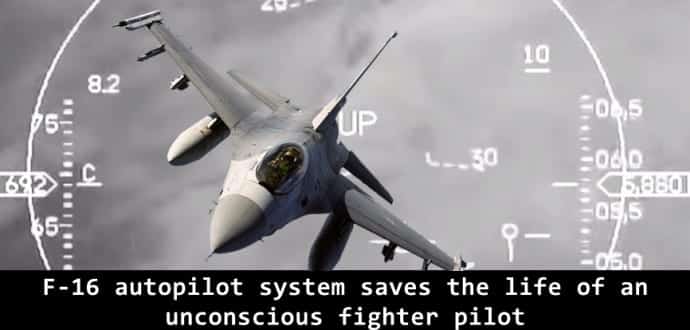F-16 autopilot system pulls unconscious pilot out of the danger zone with seconds to spare
In a recent de-classified video footage of a U.S. Air Force Arizona Air National Guard F-16, it shows how a trainee pilot who has passed out due to G-LOC is saved from certain death by the aircraft’s Automatic Ground Collision Avoidance System (Auto-GCAS). To date, Auto-GCAS has saved four pilots both in training and combat.
G-LOC, or G-Induced Loss Of Consciousness, can occur when a pilot pulls such a tight turn that the blood drains from their head, making them pass out. That’s what happened to a U.S. Air Force trainee pilot with the call sign Ocho.G-LOC
Ocho was performing some basic exercise drills over the U.S. southwest when he fell unconscious in his F-16 after reaching 8.3G. For an average person, about 5G is enough to make him unconscious. Although a trained fighter pilot can handle up to 9G, but that day 8.3G proved to be too much for the trainee.
The trainee was flying along with his instructor in a separate F-16 when G-force got the better of the pilot, and the jet began to steeply nose-dive towards the desert. The trainee’s jet plummets from an altitude of 17,000 feet to 12,320 feet as the command “2 recover” can be heard across the communications link, according to a report at Aviation Week. Again at 10,800 feet, one can hear the instructor calling to his student “2 recover.” The trainee’s jet falls down another 2,000 feet down and the instructor calls again before the F-16’s Auto-GCAS took over and flew the aircraft to safety with only seconds to spare.
“I started to roll and started to pull and I’m following [the instructor pilot] with my eyes. The next thing I remember is just waking up and hearing ‘recover’. It happened so fast. Usually, most people get tunnel vision that gradually comes in. That’s what I always get, but that day I didn’t get anything.” Ocho said.
Auto-GCAS was a joint effort between NASA, the Air Force, and Lockheed Martin. The system triggers itself on by comparing the trajectory of the aircraft to a terrain profile generated from plane’s terrain elevation data. As soon as the system predicts the two trajectory’s collision, it takes over the plane controls and initiates an automatic recovery by moving the craft upwards with a 5G pull until the data states that the plane is in control again.
“To date, this technology has saved four pilots’ lives in training and combat. This means their families didn’t lose a husband, father, son or brother,” said Lt. Col. Chris Keithley, commander of the 416th Flight Test Squadron. “It’s a huge win and I can’t overstate how meaningful it is.”

